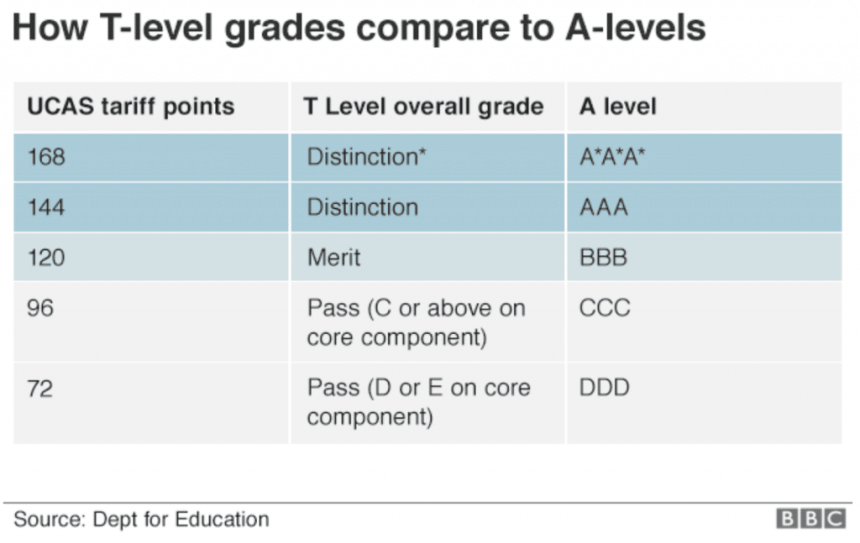Contents:
There has been a large increase in students taking vocational qualifications in the last 20 years. This is, in part, due to the 2013 change in legislation, whereby the government made it compulsory for students to continue education or training until the age of 18. Before that, students would either stay in full-time education and pursue academic qualifications, stay in further education and study for a vocational qualification, or leave school at 16 to find a job.
Those who chose to leave school at 16 would often start in low-paid and unskilled roles. The government hoped that by raising the school leaving age and providing training and qualifications, young people would leave with the knowledge and skills needed to give them a head start in their career.
Despite this major change in legislation, the vocational qualifications students can pursue have remained largely unchanged. In fact, the three most well-known qualifications − BTECs, NVQs and Apprenticeships − have been around since 1974, 1986, and 1994, respectively. Moreover, with multiple qualifications available in the same industry, the government believes the current system is “confusing and complicated” for both students and employers.
Thus, the government has begun a radical overhaul to “crack down on poor quality post-16 qualifications“. One part of this shake-up is the creation of a new qualification: T Levels.
What are T Levels?
T Levels, or Technical Levels, are vocational qualifications which follow on from GCSEs. They are level 3 qualifications that take two years to complete. Designed for 16-19 year olds, they are a happy medium between apprenticeships and A Levels by combining theory and classroom learning with practical training and work experience.
T Levels were developed in collaboration with industry experts, education providers, and companies to ensure their content meets the needs of employers and that the qualification sufficiently prepares students for the industry they are going into. As they’re based on the same rigorous standards as apprenticeships, T Levels have been approved by the Institute for Apprenticeships and Technical Education. Many employers and professional bodies have similarly endorsed this new qualification. Skilled employment, apprenticeships, and technical study through further or higher education are all pathways available to T Level students.
If your child decides to do T Levels, they will be based at a sixth form or further education college. Alongside the learning they will do in college, your child will complete a minimum of 315 hours (approximately 45 days) on an industry placement. At the end of the two year course, your child will have one T Level. This is the equivalent of 3 A Levels.
Currently, T Levels can only be studied in England. If you live elsewhere in the UK, your child will need to choose between BTECs, NVQs, and Apprenticeships or, if you live in Scotland, SVQs.
T Levels in numbers
- 1800+ contact hours
- 315+ hours on placement
- 80:20 split between classroom and placement
- 20 available sectors by 2023
- 400+ providers
What subjects do T Levels cover?
The first T Levels started being taught in September 2020 at selected centres across England. More T Levels commenced in the following years, with all currently-planned T Levels being available by September 2023. Once fully rolled out, T Levels will cover over 20 sectors, with the possibility for more in the future.
Available now:
- Accounting
- Building Services Engineering for Construction
- Design and Development for Engineering and Manufacturing
- Design, Surveying and Planning for Construction
- Digital Business Services
- Digital Production, Design, and Development
- Digital Support Services
- Education and Childcare
- Engineering, Manufacturing, Processing and Control
- Finance
- Health
- Healthcare Science
- Maintenance, Installation, and Repair for Engineering and Manufacturing
- Management and Administration
- Onsite Construction
- Science
Available from September 2023 onwards:
- Agriculture, Land Management, and Production
- Animal Care and Management
- Catering
- Craft and Design
- Hairdressing, Barbering, and Beauty Therapy
- Legal Services
- Media, Broadcast, and Production

How are T Levels taught and assessed?
Like A Levels, T Levels are classroom-based. Around 80% of the learning your child will do will be in an educational setting. Compare this to A Levels, where 100% of the qualification is classroom-based, and apprenticeships, where only 20% is completed in the classroom.
Classroom-based learning isn’t only the conventional sitting at a desk and taking notes that A Level veterans are familiar with. Your child’s timetable will be jam packed with hands-on sessions, such as in the college workshop or school lab. The practical study and technical training elements are just as important to T Levels as the theoretical component. Teaching methods are tailored to the demands of the course.
A T Level is afforded at least 1,800 hours of timetabled learning. This is split into three main sections:
- Technical qualification (TQ) is the main, classroom-based element. Students will learn about their chosen sectors through a curriculum designed by employers and developed by an awarding organisation (AO).
- Industry placement runs for a minimum of 315 hours (45 days) overall and will give students practical insights into their sector and an opportunity to embed the knowledge and skills learned in the classroom
- English, maths and digital provision is also built into the classroom-based element of the T Level, meaning students will be given a solid foundation of transferable skills
The TQ features core units, which all students are taught, and one or more occupational specialisms. These specialisms are optional modules that students choose from after they have the foundations of the industry under their belts. This gives your child freedom to pursue their interests and use what they have learned to inform future decisions.
Alongside their classroom learning, your child will spend around 20% of their time − a total of 9 weeks across the two-year course − on placement with an employer. Compared to BTECs, where only 2 weeks are spent on placement, this is substantial. This placement will give your child the chance to consolidate what they’ve learnt over a sustained period of time. Moreover, it will allow your child to get a real feel for life in their chosen industry and will provide them with valuable confidence when applying for jobs once their T Levels have been awarded.
Your child will not necessarily be limited to one placement; they may have the chance to do placements with two employers. The placement could be one continuous block, day release, or a mixture of the two.

If you or your child would like to get a better idea of what placements are like and their benefits, you can watch videos from students who have undertaken T Level placements.
Both the core and occupational specialism units are assessed; the industry placement, and any other course-specific elements, only need to be marked as complete for the qualification to be awarded. The way each T Level is assessed will depend on what is suitable for that industry. Assessment types include external examinations and projects set by employers. Unlike with A Levels, T Level assessments can take place at any time of the year.
How are T Levels graded?
Your child’s overall grade will be calculated based on how they performed in each area of their T Level. T Level grades can be compared to their A Level equivalents with the help of the table below.
The core component is graded on the familiar A* to E scale, whereas the specialisms are awarded either a Pass, Merit, or Distinction, like BTECs. These individual marks are combined to give a Pass, Merit, Distinction, or Distinction* (possible with a Distinction in the specialism and an A* in the core). This final grade, plus the individual results, are shown on the official certificate.
If your child doesn’t pass their T Level, they will get a “statement of achievement” that shows which elements were completed and their grade for each of those elements. This means if they fail one section, they will still have something to show employers − unlike with a BTEC, where students fail the whole thing.
Pearson allows students to resit the “Core exams, the Employer Set Project, or the Occupational Specialist Project, or a combination of the three“. There is no designated “resit period”. Instead, your child can take resits during Pearson’s annual exam series (i.e. when other students are taking their exams). The Core exams and Employer Set Project can be resat in the summer and November periods, while the Occupational Specialist Project can only be resat in the summer.

What are my child’s options after T Levels?
Your child can continue in education or start their job search. If they want to keep studying, they can either do this in a work-based setting via an apprenticeship, or they can apply for university.
T Levels are worth three A Levels and the UCAS tariff points reflect this. In the table above you can see that if your child achieves a Distinction, it’s the equivalent of 3 As at A Level. By aligning T Level UCAS points so closely with A Levels, the government has created a qualification which should be recognised by universities.
As the majority of the qualification is spent in the classroom, students are equipped for the intensive educational setting of university. This means T Levels offer more opportunities for higher education than other vocational courses, where there is less experience with academia. However, as the qualification is fairly new, it is unclear what requirements universities will ask for. Check out this list of higher education institutions that have confirmed T Levels will be suitable for entry onto at least one course.
If university is the route your child wants to take, it’s important to check the entry requirements of any courses they have set their eyes on. Don’t be afraid to ring up universities if you can’t find T Levels mentioned in their prospectus: this is a relatively new qualification so universities may not have updated their requirements yet, or made a decision on whether to include them in entry requirements. It’s important you know what is required for university entry before your child undertakes a qualification which may not get them where they want to go.

It should be said that T Levels weren’t designed with the traditional university route as a top priority. They aim to help more students get started on a vocational pathway. While there are more and more degrees that offer a practical element, the fundamental purpose of T Levels doesn’t complement the approach of many top universities. This, coupled with the hesitation of some universities towards T Levels and entry requirements, means it’s worthwhile considering if the stress is worth it. If your child is dead set on doing a degree, other qualifications with more established reputations and routes into higher education may suit them better.
Even if university is off the table, T Levels are still incredibly versatile qualifications that open a lot of doors for students. They have a broader focus than apprenticeships and hence can lead to a larger range of jobs in a variety of sectors. Skilled employment is a convincing prospect: T Level students are a great hire for employers because of their extended work placements and understanding of the workforce. Your child might consider doing a higher level vocational qualification (like a higher or degree apprenticeship) or applying to a professional development programme.
Where can my child do T Levels?
At the moment, depending on where you live, your child’s options may be limited. The government has compiled a list of institutions which have been selected to provide T Levels. As of September 2022, over 400 institutions offer T Levels, and this number should increase by September 2024. As with A Levels and other vocational qualifications, not all institutions will offer the whole range of T Levels.
Find your child’s nearest T Level provider and discover which subjects they will offer.
What are the entry requirements for T Levels?
Like other qualifications, it’s up to the college or sixth form to determine their own entry requirements. Moreover, different courses will have different entry requirements.
Typically, vocational qualifications have lower entry requirements than A Levels and are therefore more accessible. However, investigations by TES showed that in 2020, the majority of centres offering T Levels were asking for a minimum of a 4 in English and Maths to apply − and some were asking for even higher grades.
Colleges and sixth forms setting such high entry requirements probably wasn’t something the government was expecting. T Levels have English and Maths provision built into the classroom-based element of the qualification. This provision was meant to ensure that students didn’t need to meet a specific level in English and Maths to join the course; anyone not meeting the standard would be taught the subjects alongside their sector-specific training. Thus, even if a student hadn’t begun with what is considered a pass in GCSE English or Maths, they would leave with one. However, the government has no control over what entry requirements colleges set and, with entry requirements set higher than the government anticipated, there’s a danger a large number of students will be prevented from applying.
The government has introduced a T Level Transition Programme to help alleviate this problem.
T Level Transition Programme
This is a one-year post-GCSE course enabling students to prepare for T Levels by enhancing their relevant knowledge, skills, and work experience specific to their T Level subject area. According to the Government, students can expect to:
- Gain technical knowledge and practical skills relevant to their chosen T Level subject area
- Get ready for their T Level with industry work experience and preparation
- Improve their study skills and build a healthy, positive work ethic
- Develop industry-relevant English and maths skills, and digital skills (including the completion and attainment of GCSE English and Maths, if they don’t already have these qualifications)
- Benefit from focused individual support and personal development
- Plan the right next step for them – and get the skills to succeed when they get there
What’s the difference between BTECs, Apprenticeships, and T Levels?
BTECs and T Levels are very similar qualifications in that both are two-year long, classroom-based qualifications which will provide your child with industry-specific knowledge and skills. The main difference between them is the length of industry placement. BTECs only have a two-week placement; this means that skills learnt on the course are taught through practical sessions in college and there is limited opportunity for their implementation. T Levels, on the other hand, have a much longer placement, a minimum of 315 hours or 45 days. T Levels additionally have a minimum of 1800 contact hours, which is more than BTECs.
However, apprenticeships are very different to T Levels. More learning is done ‘on-the-job’, with around 80% of your child’s time spent on placement (unlike T Levels where 80% is spent in the classroom). As a result, apprenticeships are more geared towards a specific job than T Levels are. Apprentices spend their remaining time at a place of study. Moreover, apprentices are paid while they learn.
Are T Levels replacing BTECs?
At the moment, no your child will still be able to do BTECs. However, this may not be for very long. One of the main reasons the government is overhauling the system is to simplify it: currently they believe there are too many qualifications in each sector. To help speed up the streamlining process, from 2024, the government is planning to remove funding for qualifications that overlap with A Levels and T Levels, in order to reduce competition. Once funding is withdrawn, further education colleges and sixth forms will be forced to drop qualifications such as BTECs in favour of T Levels. The government believes this approach will simplify qualifications and ensure that students leave with qualifications that are respected by employers.
For the moment, students can still complete BTECs without issue. This roll-out has been a lengthy process so there shouldn’t be any surprises or sudden disappearances. However, if you’re concerned, you can always talk to your child’s current or prospective education provider. They will have been aware of the transition for a long time, have experience of how the funding works, and can advise on the longevity of specific courses.
Are T Levels replacing Apprenticeships?
Apprenticeships are safe. In fact, the government said: “From 2020, A Levels, T Levels and apprenticeships will be the gold standard option for young people after they take their GCSEs”.
When we started writing this article, T Levels were still in their very early infancy. Everyone knew as much − or as little − as everyone else. Now, at least, the first cohort of T Level students have got their results. Over 92% of the 1300 students achieved a Pass or above; 71% of applicants were successful in securing a university spot, with many more finding employment or an apprenticeship. Though there are still many wrinkles to iron out, this is a very promising start for the new qualification.
There’s no doubt that the current system offers a lot of choices which can make finding a vocational qualification that suits your child confusing. By streamlining the options students have post-GCSE and ensuring each qualification is robust, the government wants to ensure both students and employers can be confident with all qualifications on offer.
The government has been clear that their ‘gold standard’ for students studying vocational qualifications will be T Levels or apprenticeships. But it’s not as simple as that. The next few years are a transition period, with T Levels being slowly phased in and the status of qualifications such as BTECs unknown. The first few years with any new qualification are always bumpy, and T Levels still need to contend with low confidence among students and teachers, and a lack of awareness among employers. Their reputation is still in flux, which may be a hindrance when your child comes to search for a job. With so many things up in the air, one thing is for sure: taking a T Level now will certainly be a gamble.







Comments